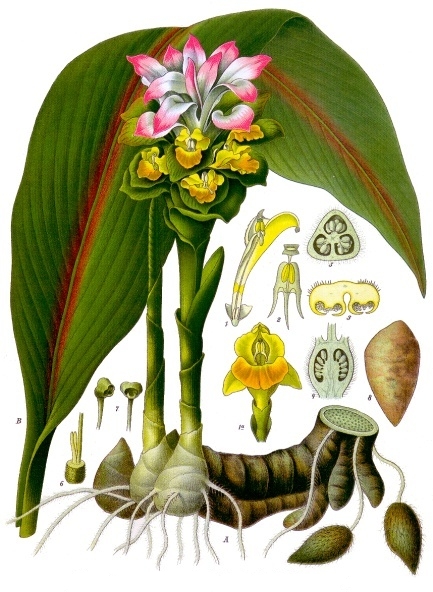Dies ist eine alte Version des Dokuments!
Zingiberaceae - syn. Amomum zedoaria Christm., white turmeric, zedoary, Weiße Curcuma, Zitwer
http://de.wikipedia.org/wiki/Zitwerwurzel
Native to Southeast Asia (Java); flowering stem 20-25cm long, appearing before the leaves; leaves 4-6, long petioled, oblong-lanceolate, finely acuminate, glabrous on both surfaces; flowers in spikes, yellow, corolla tube twice as long as calyx, funnel-shaped; fruit a ovoid capsule; ellipsoid seeds with a white lacerate aril; rootstock of palmately branched sessile cyclindric oblong annulate tubers, pale yellow inside, with camphoraceous odor and spicy taste.
„The essential oil produced from the dried roots of Curcuma zedoaria is used in perfumery and soap fabrication, as well as an ingredient in bitter tonics.“ http://en.wikipedia.org/wiki/Curcuma_zedoaria
The essential oil of C. zedoaria contains 1,8 cineol (18.5%), cymene (18.42%) and α-phellandrene (14.9%) as principal constituents. [Chemical and biocidal investigations on essential oils of some Indian Curcuma species. Gurdip Singh, Om Prakash Singh, Sumitra Maurya, Progress in Crystal Growth and Characterization of Materials, Vol.45 (1–2) 2002, 75–81]
„The essential oil obtained by hydrodistillation of the rhizome of Curcuma zedoaria native to northeast India has been analyzed by GC and GC/MS. Thirty-seven constituents representing about 87.7% of the total oil have been identified. Curzerenone (22.3%) was the major component, followed by 1,8-cineole (15.9%) and germacrone (9.0%).“ [Essential Oil of the Rhizome of Curcuma zedoaria (Christm.) Rose. Native to Northeast India, Jubilee Purkayastha, Subhan C. Nath & Naja Klinkby, Journal of Essential Oil Research, Vol.18 (2) 2006, 154-155]
„In the course of screening marketed oriental anti-inflammatory herbal drugs for TNF-α antagonistic activity, a crude methanolic extract of the rhizomes of Curcuma zedoaria exhibited significant activity. The activity-guided fractionation and repetitive chromatographic procedures with the EtOAc-soluble fraction resulted in the isolation of three active compounds. They were identified as 1,7-bis(4-hydroxyphenyl)-1,4,6-heptatrien-3-one (1), procurcumenol (2) and epiprocurcumenol (3) by spectral data analysis… These results imply that the traditional use of C. zedoaria rhizome as anti-inflammatory drug may be explained at least in part, by the inhibition of TNF-α production.“ [A Curcuminoid and Sesquiterpenes as Inhibitors of Macrophage TNF-α Release from Curcuma zedoaria. Mi Kyung Jang, Dong Hwan Sohn, Jae-Ha Ryu, Planta Med 2001; 67(6): 550-552]

